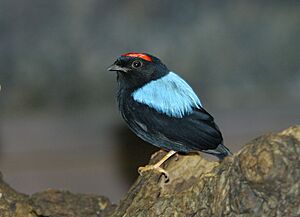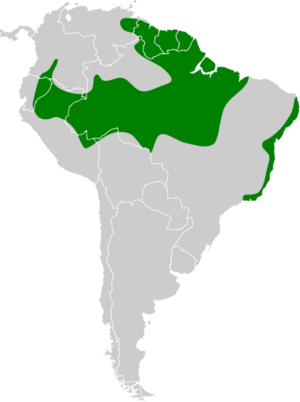Blue-backed manakin facts for kids
Quick facts for kids Blue-backed manakin |
|
|---|---|
 |
|
| male | |
| Conservation status | |
| Scientific classification | |
| Genus: |
Chiroxiphia
|
| Species: |
pareola
|
 |
|
| Synonyms | |
|
Pipra pareola Linnaeus, 1766 |
|
The blue-backed manakin (Chiroxiphia pareola) is a small, colorful bird that lives in tropical South America. You can find it from Colombia and Tobago all the way to southeastern Brazil. These birds like forests where trees lose their leaves, but not thick, evergreen rainforests.
This little bird is quite plump and usually about 13 centimeters (5 inches) long. Male blue-backed manakins are mostly black with a bright blue back. They also have a cool red or yellow spot on their head, called a crown. Females and young birds are olive-green with lighter colors on their bellies. When it's time to find a mate, the males do a special dance together! They jump and twirl to impress the females. This bird is quite common, and its population is doing well.
Contents
Where Do Blue-backed Manakins Live?
The blue-backed manakin lives in many parts of South America. You can find them in southern Colombia, eastern Venezuela, and the Guyanas. They also live in northeast Brazil, the Amazon Basin, Bolivia, Ecuador, and Peru. Plus, there's a group of them on the island of Tobago.
They are common in dry and moist forests where trees lose their leaves. However, you won't usually find them in very dense rainforests.
What Does a Blue-backed Manakin Look Like?
Like other manakins, the blue-backed manakin is a small, brightly colored forest bird. It's usually about 13 centimeters (5 inches) long and weighs around 19 grams (less than an ounce).
Male Blue-backed Manakins
The male bird is mostly black. It has a bright blue back and light orange legs. The top of its head, or crown, is usually red. But in some areas, like the southwest Amazon basin, the crown can be yellow.
Female and Young Blue-backed Manakins
Female blue-backed manakins have olive-green feathers on their upper parts. Their undersides are a bit lighter olive-green. Young males start out olive-green like the females. But as they grow up, they begin to show a red cap and their blue back starts to appear.
Tobago Manakin (C. p. atlantica)
There's a special type of blue-backed manakin that lives only on Tobago. It's called C. p. atlantica. This bird is a bit bigger. It also has more red on its crown and more blue on its back. Some people have thought this might be a separate species, but most experts still consider it a type of blue-backed manakin.
Similar Birds
The blue-backed manakin looks a bit like the lance-tailed manakin. That bird lives further north, from northern Venezuela to Costa Rica. The main difference is that the lance-tailed manakin has longer central tail feathers. Also, the male lance-tailed manakin has an even brighter blue back.
How Do Blue-backed Manakins Behave?
Male blue-backed manakins have a very interesting way of attracting females. It's called a cooperative display. This means they work together, instead of competing!
The Cooperative Dance
- Two males will sit next to each other on a bare stick.
- They take turns jumping up and down, making a buzzing sound.
- When a female comes near, the bird that is sitting moves backward under the jumping bird.
- This makes them look like they are doing a vertical circling dance!
- Sometimes, groups of up to eight birds will perform together. Each pair of dancing males uses a different stick.
Nests and Eggs
After the display, the female builds a nest out of twigs in a tree. She lays two white eggs with brown spots. The female takes care of the eggs all by herself. They hatch in about 20 days.
Calls and Food
Besides their buzzing display song, blue-backed manakins have other calls. One common call sounds like whee-whee-CHUP. Sometimes, two males will even make this sound together.
These birds mostly eat fruit. They also enjoy eating some insects.
Is the Blue-backed Manakin in Danger?
No, the blue-backed manakin is not in danger. This bird lives in a very large area and is quite common. Experts believe there are many of these birds in total. Their population seems to be stable, meaning it's not going down. Because of this, the International Union for Conservation of Nature says the bird's conservation status is of "least concern". This means it's not currently at risk.
Images for kids



